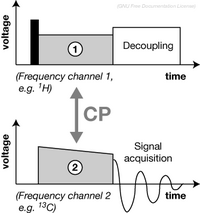Physics:Proton-enhanced nuclear induction spectroscopy
Proton-enhanced nuclear induction spectroscopy (PENIS), also called cross-polarisation (CP),[1] is a nuclear magnetic resonance technique invented by Michael Gibby and Alexander Pines (who named it specifically for the humorous acronym) while they were graduate students in the lab of Professor John S. Waugh at the Massachusetts Institute of Technology.[2] Due to the suggestive nature of its acronym, the latter name is used more often. This technique is an integral part of most solid-state NMR experiments involving spin-1/2 nuclei.[3][1]
PENIS was one of the first of Pines' experiments transferring spin orientation from one atomic nucleus to another, which has been one of the running themes throughout his career as a leading pioneer in the applications of NMR to the study of non-liquid samples. The PENIS technique was patented in 1972.[4]
Technique
In this technique the natural polarization of an abundant spin (1H, the "proton" which begins the name of the technique) is exploited to increase the polarization of a rare spin (such as 13C) by irradiating the sample with radio waves at the frequency which corresponds to the difference between the rotation frequencies of the two different spins.[5]
Besides its utility for boosting signals from dilute spins, transferring spin-polarization can also be used by surface-scientists to selectively enhance the spin-polarization of molecules on a sample's surface over the spins in the bulk by transferring spin-polarization from a gas to the surface.[6]
References
- ↑ 1.0 1.1 Oshiro, C.M. (1 June 1982). Optically enhanced nuclear cross polarization in acridine-doped fluorene (Thesis). doi:10.2172/5193797. OSTI 5193797.
- ↑ Pines, A.; Gibby, M.G.; Waugh, J.S. (August 1972). "Proton-enhanced nuclear induction spectroscopy 13C chemical shielding anisotropy in some organic solids". Chemical Physics Letters 15 (3): 373–376. doi:10.1016/0009-2614(72)80191-X. Bibcode: 1972CPL....15..373P.
- ↑ Weber, Daniel K.; Bader, Taysir; Larsen, Erik K.; Wang, Songlin; Gopinath, Tata; Distefano, Mark; Veglia, Gianluigi (2019). "Cysteine-ethylation of tissue-extracted membrane proteins as a tool to detect conformational states by solid-state NMR spectroscopy". Methods in Enzymology. 621. pp. 281–304. doi:10.1016/bs.mie.2019.02.001. ISBN 978-0-12-818117-1.
- ↑ "Proton-enhanced nuclear induction spectroscopy" US patent 3792346
- ↑ Pines, A.; Gibby, M. G.; Waugh, J. S. (15 July 1973). "Proton‐enhanced NMR of dilute spins in solids". The Journal of Chemical Physics 59 (2): 569–590. doi:10.1063/1.1680061. Bibcode: 1973JChPh..59..569P.
- ↑ Raftery, Daniel; MacNamara, Ernesto; Fisher, Gregory; Rice, Charles V.; Smith, Jay (September 1997). "Optical Pumping and Magic Angle Spinning: Sensitivity and Resolution Enhancement for Surface NMR Obtained with Laser-Polarized Xenon". Journal of the American Chemical Society 119 (37): 8746–8747. doi:10.1021/ja972035d.


